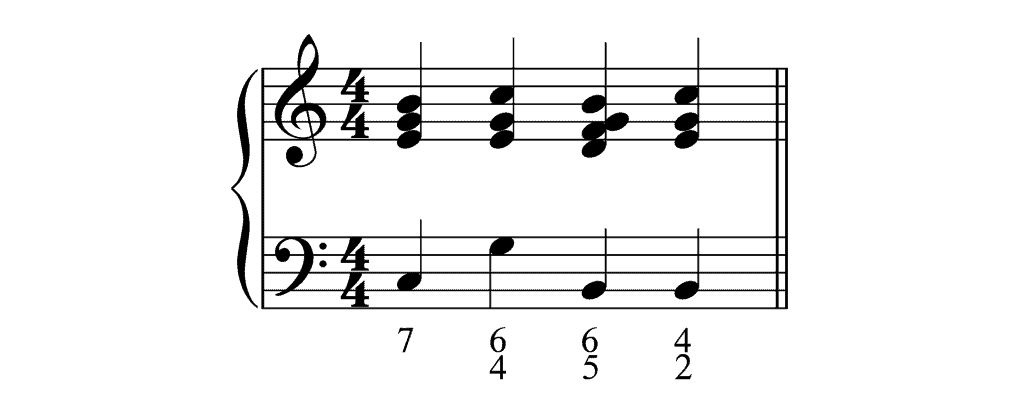Music can be written down or notated in many ways. Different countries and different eras – Classical, Romantic, Baroque, etc. – all have different rules for how to notate a piece of music and all of the performance markings and articulations that go with it.
In this post, we’ll look at one specific notation style called Figured Bass. We’ll explore what it is, how to read and write it, and when it is used and why.
Figured Bass Notation
Figured Bass is a specific kind of notation in which the composer writes numbers below bass notes in the lower staff, and those numbers represent the chords made above the bass notes.
Also called throughbass, this notation style was used predominantly during the Baroque Era in the 17th and 18th centuries, but it is still used and taught today.
Here’s an example:

So, like in this example, the numbers are connected to the bass notes (the notes in the lower staff) and they tell us what the harmonization is above the bass notes – which is written out in the upper staff.
How to Read and Write Figured Bass
There are two different sets of numbers that can be found below a bass note in figured bass notation, depending on if the chords above it are triads or seventh chords.
With triads – chords with three notes – there are three different notes the chord could start on, and therefore three different notes that could be the bass note.
These notes are the root, the 3rd, and the 5th:

If the bass note is the root of the chord, then there is no number below it.
If the bass note is the 3rd, then there is a “6” written below it.
If the bass note is the 5th, then there is a “6 4” written below it (vertically, with the 6 stacked on top of the 4).
Here is an F Maj triad (F – A – C) with the root, 3rd, and 5th in the bass:

Because Seventh chords have 4 notes, there are 4 notes that can be in the bass – the root, 3rd, 5th, and 7th.
- If the bass note is the root of a Seventh chord, then there is a “7” written below it.
- If the bass note is the 3rd of a Seventh chord, then there is a “6 5” written below it.
- If the bass note is the 5th of a Seventh chord, then there is a “4 3” written below it.
If the bass note is the 7th of a Seventh chord, then there is a “4 2” written below it.
Here is a CMaj7 chord (C – E – G – B) with the root, 3rd, 5th, and 7th in the bass:

What Do the Numbers Mean in Figured Bass?
The numbers under the bass note indicate the intervals of the notes that will be placed above it.
So, if you have a C in the bass and a 5 below it, that means that there should be a note a 5th above it, which would be a G (C ⇨ G is an interval of a 5th).
A root position triad has the root, 3rd, and 5th, and is the normal position of a triad.
Therefore, a normal root position bass note would always have the numbers “5 3” below it.
Because of this, the numbers 5 and 3 are not necessary to write down in figured bass.
This is why you see root position chords either have no numbers or just a 7 for seventh chords.
Examples:
First position Seventh chords, which is a Seventh chord built on the 3rd, has the following intervals above that note: 3, 5, and 6.
In a CMaj7 chord (notes: C – E – G – B) starting on E, the 3rd, those notes would be G, B, and C above the E.
And E ⇨ G is a 3rd, E ⇨ B is a 5th, and E ⇨ C is a 6th.

This would mean under that bass note we could have the numbers 6 5 3.
However, we don’t need the 5 and 3, BUT we also can’t just put a 6 because that means a first inversion triad, so therefore we have to write “6 5”.
A Seventh chord built on the 7th in the root would have notes that are a 2nd, 4th, and 6th above it.
We can minimize the numbers by just writing “4 2”, which people now know as 3rd inversion Seventh chords.
Accidentals in Figured Bass
Sometimes you see an accidental (#, b, or ♮) under a bass note, or next to a number below a bass note.
Here’s an example in context from Bach’s “Beschraenkt, ihr Weisen”.
The smaller note heads are the notes mentioned by the figured bass numbers:
If the accidental is next to a number, it means that you add an accidental to the note that the number represents.
For example, a “b6 4” below a note will mean that the note a 6th above it is flattened.
With C as the bass note, “b6 4” means you have an F (C ⇨ F is a 4th) and an Ab (C ⇨ A is a 6th, then flatten it to Ab).
This gives you C – F – Ab, which is a F min chord built from the 5th.
If you have just a “#” or “b” below a note in figured bass, that means the note a 3rd above it will be sharpened or flattened.
For example, in a D min key, if you have a D in the bass note and just a “#” below it, it means the F (because D ⇨ F is a 3rd) is sharpened to F#.
Figured Bass in Summary
To sum up, all figured bass means is that you’ll see numbers and accidentals below notes in the bass clef or bass staff.
These numbers then represent what notes you can play on top of those bass notes.
Often you’ll find figured bass below music that only has bass notes, because it wants you to fill in the higher notes yourself.

